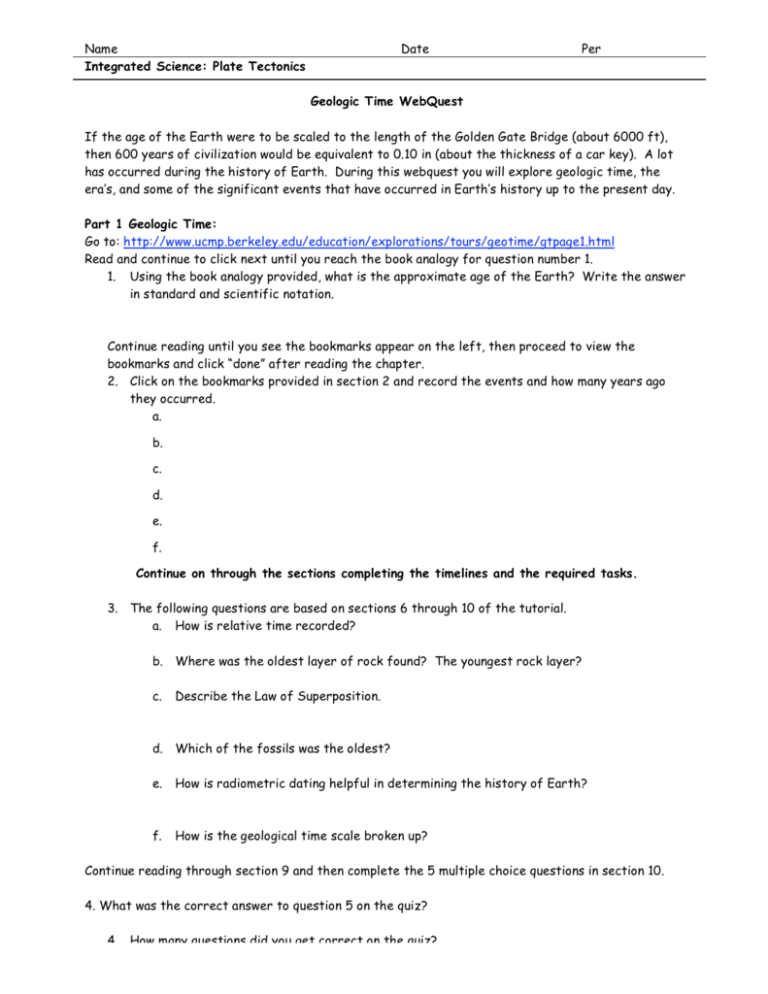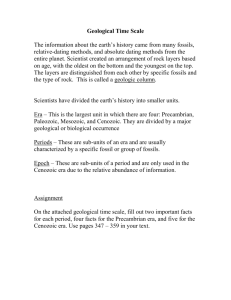geologic time webquest
advertisement

Name Integrated Science: Plate Tectonics Date Per Geologic Time WebQuest If the age of the Earth were to be scaled to the length of the Golden Gate Bridge (about 6000 ft), then 600 years of civilization would be equivalent to 0.10 in (about the thickness of a car key). A lot has occurred during the history of Earth. During this webquest you will explore geologic time, the era’s, and some of the significant events that have occurred in Earth’s history up to the present day. Part 1 Geologic Time: Go to: http://www.ucmp.berkeley.edu/education/explorations/tours/geotime/gtpage1.html Read and continue to click next until you reach the book analogy for question number 1. 1. Using the book analogy provided, what is the approximate age of the Earth? Write the answer in standard and scientific notation. Continue reading until you see the bookmarks appear on the left, then proceed to view the bookmarks and click “done” after reading the chapter. 2. Click on the bookmarks provided in section 2 and record the events and how many years ago they occurred. a. b. c. d. e. f. Continue on through the sections completing the timelines and the required tasks. 3. The following questions are based on sections 6 through 10 of the tutorial. a. How is relative time recorded? b. Where was the oldest layer of rock found? The youngest rock layer? c. Describe the Law of Superposition. d. Which of the fossils was the oldest? e. How is radiometric dating helpful in determining the history of Earth? f. How is the geological time scale broken up? Continue reading through section 9 and then complete the 5 multiple choice questions in section 10. 4. What was the correct answer to question 5 on the quiz? 4. How many questions did you get correct on the quiz? Part 2, Events in Time: Go to: http://science.nationalgeographic.com/science/prehistoric-world/prehistoric-time-line.html Click on “Explore The Time Line” You will begin with the oldest era, the Precambrian era. Precambrian 1. When did the Era begin and end? 2. List the important events that occurred in the Precambrian era. a. b. c. 3. Explore more about the world’s oldest known rocks by clicking on the icon. How old are these rocks? 4. How old are the oldest known minerals? Paleozoic 1. When did the Era begin and end? 2. List the important events that occurred in the Paleozoic Era. a. b. c. d. e. f. g. h. i. j. k. 3. Choose an even to read more about, other than the extinction, and briefly describe the event below. 4. Learn more about the extinction that occurred at the end of the Paleozoic era. Describe how life was affected and the theory behind the extinction. Mesozoic 1. When did the Era begin and end? 2. List the important events that occurred in the Mesozoic Era. a. b. c. d. e. f. g. 3. Learn more about the dinosaur extinction that occurred at the end of the era. Include how life on the planet was affected and the thought as to how the extinction occurred. Cenozoic 1. When did the Era begin and end? 2. List the important events that occurred in the Cenozoic Era. a. b. c. d. e. 3. Learn more about how mammals filled dinosaurs shoes. Determine the types of mammals that were thought to take over after dinosaurs went extinct. 4. When did the most recent ice age end? 5. How long ago did the modern hominid, Homo sapiens, first emerge in the fossil record? Part 3 Environment and Fossils: Go to: http://fossils.valdosta.edu/home_time.html Choose one period from each of the Era’s to explore further using the website above. Click on the period of your choice on the left hand side of the screen. A map will appear that represents the arrangement of landmasses during that time. Scroll over the different environments to determine if it existed during that time period. Complete the table below by putting a check mark that corresponds to a specific environment that existed during the time period. Cenozoic Quaternary Tertiary Mesozoic Cretaceous Jurassic Triassic Permian Pennsylvanian Paleozoic Mississippian Devonian Silurian Ordovician Cambrian √ √ √ √ Shallow seas Mountain Forest Description of fossil (click on Glaciers Period Deserts Era √ Description of landmasses Continents are defined and spread out, separated by large oceans. a species below the map and if present it will be highlighted on the map; then click on any highlighted area to view fossil) Name: Pachyornis elephantopus Type: bird Modern day species it resembles: Ostrich Precambrian








